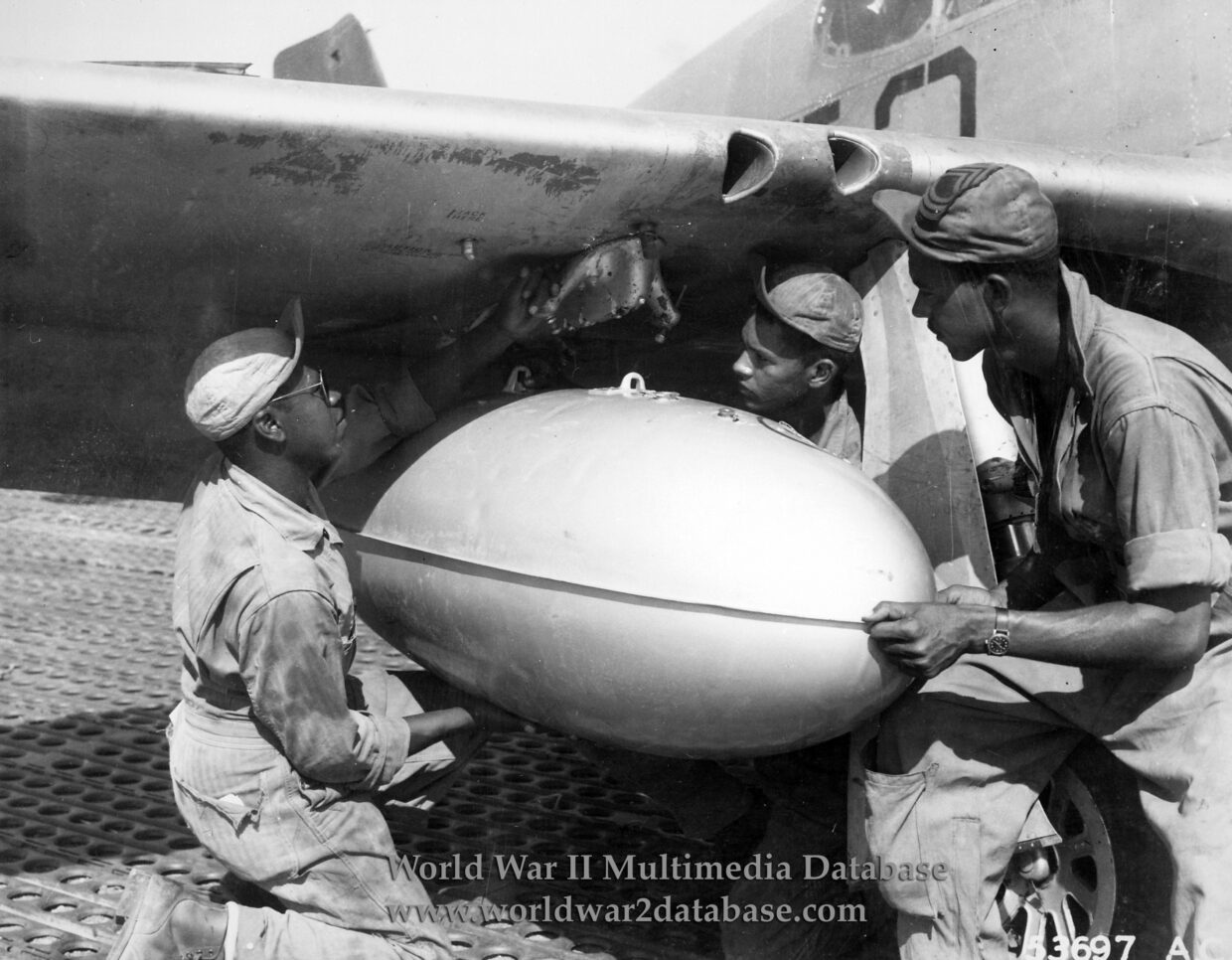| Technical Sergeant Charles Kemper Haynes of Saint Louis, Missouri (June 14, 1910-April 3, 1995), Staff Sergeant James A. Sheppard of New York, New York (September 20, 1924- ) and Master Sergeant Frank Bradley of Los Angeles, California (1915-????) affix a 75-gallon drop tank to the bomb shackle on the wing of a North American P-51C Mustang “Yvonne“ of the 301st Fighter Squadron, 332nd Fighter Group, 306th Fighter Wing, Fifteenth Air Force. Contrary to some other captions for this photo, the tanks were mounted empty and then filled. A pint of fuel would be removed before flight, which usually collected the water and contaminants from the tank. Note wear on leading edge of the wing. Sheppard graduated from Haaren High School in New York City as a qualified aviation mechanic in June 1942 and can remember Navy recruiters refusing to meet with the black students after Pearl Harbor. He was immediately sent to Tuskegee when he entered service on October 14, promised pilot training. However, upon arrival he was assigned as a mechanic because he was already certified. Haynes and Bradley completed ground school at either Lincoln, Nebraska or Chicago, Illinois. Soon Sheppard joined the 100th squadron and was sent to Italy, where he remained for the duration of the war. He received a three-week course in the Packard-built Merlin V-16-50 engine, which was used in the P-51. Sheppard remembers that the day of the photo, a United States Army Signal Corps photo unit was shooting film and the other two men came over to help with the fuel tank on camera, which normally was affixed by only one man. If there was no damage to the aircraft, a plane could be readied for its next mission in six hours; oil or ethylene glycol leaks took eight to twelve hours to fix, while a coolant leak took two days, as the entire engine had to be stripped and checked. Often the ground crews would work by floodlight to ready the aircraft for the next day‘s mission. Contrary to popular myth, beer was not stowed in the fuel tanks for chiling at high altitude; the chance of blocking the fuel line was too great. Sheppard and other crew chiefs complained about the red tail order from General Nathan F. Twining, who wanted his fighters to be easily identifiable in the air, so all groups were assigned tail colors in early 1944. This P-51‘s red tail can be seen in the upper left of the photo. The ground crews protested this added work, which required constant touch-ups. When Twining sent the order, some of the 332nd fighter group‘s men wondered if the red color was picked to make the African-American pilots easier targets for the Axis. After the war, Sheppard became a pilot and safety inspector for the Federal Aviation Administration, as well as remaining in the Air Force Reserves as a flight engineer, retiring as a Master Sergeant in 1961. | |
| Image Filename | wwii0020.jpg |
| Image Size | 2.90 MB |
| Image Dimensions | 2928 x 2280 |
| Photographer | Unknown |
| Photographer Title | United States Army Signal Corps |
| Caption Author | Jason McDonald |
| Date Photographed | September 01, 1944 |
| Location | Ramitelli Air Field |
| City | Ramitelli |
| State or Province | Campobosso |
| Country | Italy |
| Archive | National Archives and Records Administration |
| Record Number | NARA 208-AA-49E-1-3 |
| Status | Caption ©2007, ©2024 MFA Productions LLC Image in the Public Domain |

Author of the World War II Multimedia Database

